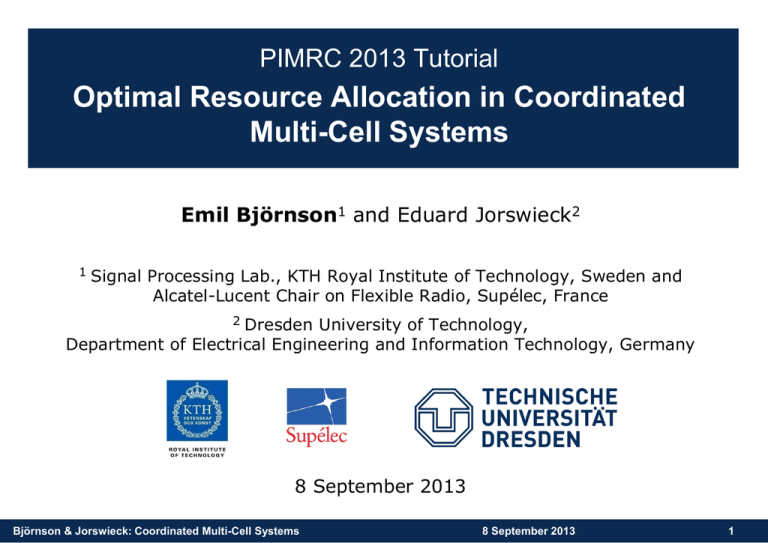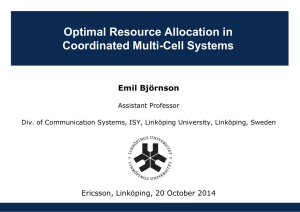Part 1 - Communication Systems division
advertisement

PIMRC 2013 Tutorial Optimal Resource Allocation in Coordinated Multi-Cell Systems Emil Björnson1 and Eduard Jorswieck2 1 Signal Processing Lab., KTH Royal Institute of Technology, Sweden and Alcatel-Lucent Chair on Flexible Radio, Supélec, France 2 Dresden University of Technology, Department of Electrical Engineering and Information Technology, Germany 8 September 2013 Björnson & Jorswieck: Coordinated Multi-Cell Systems 8 September 2013 1 Biography: Emil Björnson • 1983: Born in Malmö, Sweden • 2007: Master of Science in Engineering Mathematics, Lund University, Sweden • 2011: PhD in Telecommunications, KTH, Stockholm, Sweden Advisors: Björn Ottersten, Mats Bengtsson • 2012: Recipient of International Postdoc Grant from Sweden. Work with Prof. Mérouane Debbah at Supélec on “Optimization of Green Small-Cell Networks” Björnson & Jorswieck: Coordinated Multi-Cell Systems 8 September 2013 2 Biography: Eduard Jorswieck • 1975: Born in Berlin, Germany • 2000: Dipl.-Ing. in Electrical Engineering and Computer Science, TU Berlin, Germany • 2004: PhD in Electrical Engineering, TU Berlin, Germany Advisor: Holger Boche • 2006: Post-Doc Fellowship and Assistant Professorship at KTH Stockholm, Sweden • 2008: Full Professor and Head of Chair of Communications Theory at TU Dresden, Germany Björnson & Jorswieck: Coordinated Multi-Cell Systems 8 September 2013 3 Book Reference • Tutorial is Based on a Recent Book: Optimal Resource Allocation in Coordinated Multi-Cell Systems Research book by E. Björnson and E. Jorswieck Foundations and Trends in Communications and Information Theory, Vol. 9, No. 2-3, pp. 113-381, 2013 - 270 pages - E-book for free (from our homepages) - Printed book: Special price $35, use link: https://ecommerce.nowpublishers.com/shop/add_to_cart?id=1595 - Matlab code is available online Check out: http://flexible-radio.com/emil-bjornson Björnson & Jorswieck: Coordinated Multi-Cell Systems 8 September 2013 4 General Outline • Book Consists of 4 Chapters • Introduction - Problem formulation and general system model • Optimal Single-Objective Resource Allocation - Which problems are practically solvable? Covered by Emil Björnson in first 90 mins • Structure of Optimal Resource Allocation - How does to optimal solution look like? • Extensions and Generalizations - Applications to 9 current research topics - E.g., channel uncertainty, distributed optimization, hardware impairments, cognitive radio, etc. Björnson & Jorswieck: Coordinated Multi-Cell Systems 8 September 2013 Covered by Eduard Jorswieck in second 90 mins 5 Outline: Part 1 • Introduction - Multi-cell structure, system model, performance measure • Problem Formulation - Resource allocation: Multi-objective optimization problem • Subjective Resource Allocation - Utility functions, different computational complexity • Structure of Optimal Beamforming - Beamforming parametrization and its applications Björnson & Jorswieck: Coordinated Multi-Cell Systems 8 September 2013 6 Section Introduction Björnson & Jorswieck: Coordinated Multi-Cell Systems 8 September 2013 7 Introduction • Problem Formulation (vaguely): - Transfer information wirelessly to users - Divide radio resources among users (time, frequency, space) • Downlink Coordinated Multi-Cell System - Many transmitting base stations (BSs) - Many receiving users • Sharing a Frequency Band - All signals reach everyone! • Limiting Factor - Inter-user interference Björnson & Jorswieck: Coordinated Multi-Cell Systems 8 September 2013 8 Introduction: Multi-Antenna Transmission • Traditional Ways to Manage Interference - Avoid and suppress in time and frequency domain - Results in orthogonal access techniques: TDMA, OFDMA, etc. • Multi-Antenna Transmission Main difference from classical resource allocation! - Beamforming: Spatially directed signals - Adaptive control of interference - Serve multiple users: Space-division multiple access (SDMA) Björnson & Jorswieck: Coordinated Multi-Cell Systems 8 September 2013 9 Introduction: From Single-Cell to Multi-Cell • Naïve Multi-Cell Extension - Divide BS into disjoint clusters SDMA within each cluster Avoid inter-cluster interference Fractional frequency-reuse • Coordinated Multi-Cell Transmission - SDMA in multi-cell: All BSs collaborate - Frequency-reuse one: Interference managed by beamforming - Many names: co-processing, coordinated multi-point (CoMP), network MIMO, multi-cell processing • Almost as One Super-Cell - But: Different data knowledge, channel knowledge, power constraints! Björnson & Jorswieck: Coordinated Multi-Cell Systems 8 September 2013 10 Basic Multi-Cell Coordination Structure • General Multi-Cell Coordination - Adjacent base stations coordinate interference - Some users served by multiple base stations Dynamic Cooperation Clusters • Inner Circle : Serve users with data • Outer Circle : Suppress interference • Outside Circles: Negligible impact Impractical to acquire information Difficult to coordinate decisions • E. Björnson, N. Jaldén, M. Bengtsson, B. Ottersten, “Optimality Properties, Distributed Strategies, and Measurement-Based Evaluation of Coordinated Multicell OFDMA Transmission,” IEEE Trans. on Signal Processing, 2011. Björnson & Jorswieck: Coordinated Multi-Cell Systems 8 September 2013 11 Example: Ideal Joint Transmission • All Base Stations Serve All Users Jointly = One Super Cell Björnson & Jorswieck: Coordinated Multi-Cell Systems 8 September 2013 12 Example: Wyner Model • Abstraction: User receives signals from own and neighboring base stations • One or Two Dimensional Versions • Joint Transmission or Coordination between Cells Björnson & Jorswieck: Coordinated Multi-Cell Systems 8 September 2013 13 Example: Coordinated Beamforming Special Case Interference channel • One Base Station Serves Each User • Interference Coordination Across Cells Björnson & Jorswieck: Coordinated Multi-Cell Systems 8 September 2013 14 Example: Soft-Cell Coordination • Heterogeneous Deployment - Conventional macro BS overlaid by short-distance small BSs - Interference coordination and joint transmission between layers Björnson & Jorswieck: Coordinated Multi-Cell Systems 8 September 2013 15 Example: Cognitive Radio Other Examples Spectrum sharing between operators Physical layer security • Secondary System Borrows Spectrum of Primary System - Underlay: Interference limits for primary users Björnson & Jorswieck: Coordinated Multi-Cell Systems 8 September 2013 16 Resource Allocation: First Definition • Problem Formulation (imprecise): - Select beamforming to maximize “system utility” - Means: Allocate power to users and in spatial dimensions - Satisfy: Physical, regulatory & economic constraints • Some Assumptions: - Linear transmission and reception - Perfect synchronization (whenever needed) - Flat-fading channels (e.g., using OFDM) - Perfect channel knowledge - Ideal transceiver hardware - Centralized optimization Björnson & Jorswieck: Coordinated Multi-Cell Systems Will be relaxed in Part 2 8 September 2013 17 Multi-Cell System Model • 𝐾𝑟 Users: Channel vector to User 𝑘 from all BSs • 𝑁𝑗 Antennas at 𝑗th BS (dimension of h𝑗𝑘 ) • 𝑁= 𝑗 𝑁𝑗 Antennas in Total (dimension of h𝑘 ) One System Model for Any Multi-Cell Scenario! Björnson & Jorswieck: Coordinated Multi-Cell Systems 8 September 2013 18 Multi-Cell System Model: Dynamic Cooperation Clusters • How are D𝑘 and C𝑘 Defined? - Consider User 𝑘: • Interpretation: - Block-diagonal matrices - D𝑘 has identity matrices for BSs that send data - C𝑘 has identity matrices for BSs that can/should coordinate interference Björnson & Jorswieck: Coordinated Multi-Cell Systems 8 September 2013 19 Multi-Cell System Model: Dynamic Cooperation Clusters (2) • Example: Coordinated Beamforming - This is User 𝑘 - Beamforming: D𝑘 v𝑘 Data only from BS1: - Effective channel: C𝑘 h𝑘 Interference from all BSs: Björnson & Jorswieck: Coordinated Multi-Cell Systems 8 September 2013 20 Multi-Cell System Model: Power Constraints • Need for Power Constraints - Limit radiated power according to regulations Protect dynamic range of amplifiers Manage cost of energy expenditure Control interference to certain users All at the same time • 𝐿 General Power Constraints: Weighting matrix (Positive semi-definite) Björnson & Jorswieck: Coordinated Multi-Cell Systems Limit (Positive scalar) 8 September 2013 21 Multi-Cell System Model: Power Constraints (2) • Recall: • Example 1, Total Power Constraint: • Example 2, Per-Antenna Constraints: • Example 3, Control Interference to User 𝑖 Björnson & Jorswieck: Coordinated Multi-Cell Systems 8 September 2013 22 Introduction: How to Measure User Performance? • Mean Square Error (MSE) - Difference: transmitted and received signal - Easy to Analyze - Far from User Perspective? All improves with SINR: • Bit/Symbol Error Probability (BEP/SEP) - Probability of error (for given data rate) - Intuitive interpretation - Complicated & ignores channel coding Signal Interference + Noise • Information Rate - Bits per “channel use” - Mutual information: perfect and long coding - Anyway closest to reality? Björnson & Jorswieck: Coordinated Multi-Cell Systems 8 September 2013 23 Introduction: Generic Measure User Performance • Generic Model - Any function of signal-to-interference-and-noise ratio (SINR): for User 𝑘 - Increasing and continuous function - For simplicity: 𝑔𝑘 0 = 0 • Examples: - Information rate: - MSE: • Complicated Function - Depends on all beamforming vectors v1 , … , v𝐾𝑟 Björnson & Jorswieck: Coordinated Multi-Cell Systems 8 September 2013 24 Section: Introduction Questions? Björnson & Jorswieck: Coordinated Multi-Cell Systems 8 September 2013 25 Section Problem Formulation Björnson & Jorswieck: Coordinated Multi-Cell Systems 8 September 2013 26 Problem Formulation • General Formulation of Resource Allocation: • Multi-Objective Optimization Problem - Generally impossible to maximize for all users! - Must divide power and cause inter-user interference Björnson & Jorswieck: Coordinated Multi-Cell Systems 8 September 2013 27 Performance Region • Definition: Achievable Performance Region - Contains all feasible combinations - Feasible = Achieved by some v1 , … , v𝐾𝑟 under power constraints Care about user 2 Pareto Boundary Balance between users Part of interest: Pareto boundary 2-User Performance Region Björnson & Jorswieck: Coordinated Multi-Cell Systems Care about user 1 Cannot improve for any user without degrading for other users Other Names Rate Region Capacity Region MSE Region, etc. 8 September 2013 28 Performance Region (2) • Definitions of Pareto Boundary - Strong Pareto point: Improve for any user Degrade for other user - Weak Pareto point: Cannot simultaneously improve for all users • Weak Definition is More Convenient - Boundary is compact and simply-connected Optimality Condition 1 Optimality Condition 2 Sending one stream per user is sufficient (assumed earlier) At least one power constraint is active (=holds with equality) • X. Shang, B. Chen, H. V. Poor, “Multiuser MISO Interference Channels With Single-User Detection: Optimality of Beamforming and the Achievable Rate Region,” IEEE Trans. on Information Theory, 2011. • R. Mochaourab and E. Jorswieck, “Optimal Beamforming in Interference Networks with Perfect Local Channel Information,” IEEE Trans. on Signal Processing, 2011. Björnson & Jorswieck: Coordinated Multi-Cell Systems 8 September 2013 29 Performance Region (3) • Can the region have any shape? • No! Can prove that: - Compact set - Normal set Upper corner in region, everything inside region Björnson & Jorswieck: Coordinated Multi-Cell Systems 8 September 2013 30 Performance Region (4) • Some Possible Shapes User-Coupling Weak: Convex Strong: Concave Scheduling Time-sharing for strongly coupled users Select multiple points Hard: Unknown region Björnson & Jorswieck: Coordinated Multi-Cell Systems 8 September 2013 31 Performance Region (5) • Which Pareto Optimal Point to Choose? - Tradeoff: Aggregate Performance vs. Fairness Utilitarian point (Max sum performance) Utopia point (Combine user points) Single user point Performance Region Egalitarian point (Max fairness) Single user point No Objective Answer Utopia point outside of region Only subjective answers exist! Björnson & Jorswieck: Coordinated Multi-Cell Systems 8 September 2013 32 Section: Problem Formulation Questions? Björnson & Jorswieck: Coordinated Multi-Cell Systems 8 September 2013 33 Section Subjective Resource Allocation Björnson & Jorswieck: Coordinated Multi-Cell Systems 8 September 2013 34 Subjective Approach • System Designer Selects Utility Function - Describes subjective preference - Increasing and continuous function Put different weights to move between extremes • Examples: Sum performance: Proportional fairness: Harmonic mean: Max-min fairness: Known as A Priori Approach Select utility function before optimization Björnson & Jorswieck: Coordinated Multi-Cell Systems 8 September 2013 35 Subjective Approach (2) • Utilities Functions Has Different Shapes - Curve: 𝑓 g = constant - Optimal constant: Curve intersects optimum Symmetric region: Same point Björnson & Jorswieck: Coordinated Multi-Cell Systems Asymmetric region: Different points 8 September 2013 36 Subjective Approach (3) • Utility Function gives Single-Objective Optimization Problem: • This is the Starting Point of Many Researchers - Although Selection of is Inherently Subjective Affects the Solvability Pragmatic Approach Try to Select Utility Function to Enable Efficient Optimization Björnson & Jorswieck: Coordinated Multi-Cell Systems 8 September 2013 37 Complexity of Single-Objective Optimization Problems • Classes of Optimization Problems - Different scaling with number of parameters and constraints • Main Classes - Convex: Polynomial time solution Practically solvable - Monotonic: Exponential time solution Approximations needed - Arbitrary: More than exponential time Hard to even approximate Björnson & Jorswieck: Coordinated Multi-Cell Systems 8 September 2013 38 Complexity of Resource Allocation Problems • What is a Convex Problem? - Recall definitions: Convex Function For any two points on the graph of the function, the line between the points is above the graph Examples: Convex Problem Convex if objective 𝑓0 and constraints 𝑓1 , … , 𝑓𝑀 are convex functions Björnson & Jorswieck: Coordinated Multi-Cell Systems 8 September 2013 39 Complexity of Resource Allocation Problems (2) • When is Resource Allocation a Convex Problem? - Original problem: - Rewritten problem (replace SINR 𝑘 with variable ): Can be selected to be convex SINR constraints: Main complication! Convex power constraints Björnson & Jorswieck: Coordinated Multi-Cell Systems 8 September 2013 40 Classification of Resource Allocation Problems • Classification of Three Important Problems - The “Easy” problem - Weighted max-min fairness - Weighted sum performance • We will see: These have Different Complexities - Difficulty: Too many spatial degrees of freedom - Convex problem only if search space is particularly limited - Monotonic problem in general Björnson & Jorswieck: Coordinated Multi-Cell Systems 8 September 2013 41 Complexity Example 1: The “Easy” Problem • Given Any Point (𝑔1 , … , 𝑔𝐾𝑟 ) or SINRs (𝛾1 , … , 𝛾𝐾𝑟 ) - Find beamforming v1 , … , v𝐾𝑟 that attains this point - Fixed SINRs make the constraints convex: Second order cone: Convex - Global solution in polynomial time – use CVX, Yalmip Total Power Constraints • M. Bengtsson, B. Ottersten, “Optimal Downlink Beamforming Using Semidefinite Optimization,” Proc. Allerton, 1999. • A. Wiesel, Y. Eldar, and S. Shamai, “Linear precoding via conic optimization for fixed MIMO receivers,” IEEE Trans. on Signal Processing, 2006. Per-Antenna • W. Yu and T. Lan, “Transmitter optimization for the multi-antenna downlink with Constraints per-antenna power constraints,” IEEE Trans. on Signal Processing, 2007. General Constraints • E. Björnson, G. Zheng, M. Bengtsson, B. Ottersten, “Robust Monotonic Optimization Framework for Multicell MISO Systems,” IEEE Trans. on Signal Processing, 2012. Björnson & Jorswieck: Coordinated Multi-Cell Systems 8 September 2013 42 Complexity Example 2: Max-Min Fairness • How to Classify Weighted Max-Min Fairness? - Property: Solution makes 𝑤𝑘 𝑔𝑘 the same for all 𝑘 Solution is on this line Line in direction (𝑤1 , … , 𝑤𝐾𝑟 ) Björnson & Jorswieck: Coordinated Multi-Cell Systems 8 September 2013 43 Complexity Example 2: Max-Min Fairness (2) • Simple Line-Search: Bisection - Iteratively Solving Convex Problems (i.e., quasi-convex) 1. Find start interval 2. Solve the “easy” problem at midpoint 3. If feasible: Remove lower half Else: Remove upper half 4. Iterate Subproblem: Convex optimization Line-search: Linear convergence One dimension (independ. #users) Björnson & Jorswieck: Coordinated Multi-Cell Systems 8 September 2013 44 Complexity Example 2: Max-Min Fairness (3) • Classification of Weighted Max-Min Fairness: - Quasi-convex problem (belongs to convex class) - Polynomial complexity in #users, #antennas, #constraints - Might be feasible complexity in practice Early work Main references • T.-L. Tung and K. Yao, “Optimal downlink power-control design methodology for a mobile radio DS-CDMA system,” in IEEE Workshop SIPS, 2002. • M. Mohseni, R. Zhang, and J. Cioffi, “Optimized transmission for fading multipleaccess and broadcast channels with multiple antennas,” IEEE Journal on Sel. Areas in Communications, 2006. • A. Wiesel, Y. Eldar, and S. Shamai, “Linear precoding via conic optimization for fixed MIMO receivers,” IEEE Trans. on Signal Processing, 2006. Channel uncertainty • E. Björnson, G. Zheng, M. Bengtsson, B. Ottersten, “Robust Monotonic Optimization Framework for Multicell MISO Systems,” IEEE Trans. on Signal Processing, 2012. Björnson & Jorswieck: Coordinated Multi-Cell Systems 8 September 2013 45 Complexity Example 3: Weighted Sum Performance • How to Classify Weighted Sum Performance? - Geometrically: 𝑤1 𝑔1 + 𝑤2 𝑔2 = opt-value is a line Opt-value is unknown! - Björnson & Jorswieck: Coordinated Multi-Cell Systems Distance from origin is unknown Line Hyperplane (dim: #user – 1) Harder than max-min fairness Non-convex problem 8 September 2013 46 Complexity Example 3: Weighted Sum Performance (2) • Classification of Weighted Sum Performance: - Non-convex problem Power constraints: Convex Utility: Monotonic increasing/decreasing in beamforming vectors Therefore: Monotonic problem • Can There Be a Magic Algorithm? - No, provably NP-hard (Non-deterministic Polynomial-time hard) - Exponential complexity but in which parameters? (#users, #antennas, #constraints) • Z.-Q. Luo and S. Zhang, “Dynamic spectrum management: Complexity and duality,” IEEE Journal of Sel. Topics in Signal Processing, 2008. • Y.-F. Liu, Y.-H. Dai, and Z.-Q. Luo, “Coordinated beamforming for MISO interference channel: Complexity analysis and efficient algorithms,” IEEE Trans. on Signal Processing, 2011. Björnson & Jorswieck: Coordinated Multi-Cell Systems 8 September 2013 47 Complexity Example 3: Weighted Sum Performance (3) • Are Monotonic Problems Impossible to Solve? - No, not for small problems! • Monotonic Optimization Algorithms - Improve Lower/upper bounds on optimum: - Continue until - Subproblem: Essentially weighted max-min fairness problem Monotonic • H. Tuy, “Monotonic optimization: Problems and solution approaches,” SIAM Journal optimization of Optimization, 2000. Early works • L. Qian, Y. Zhang, and J. Huang, “MAPEL: Achieving global optimality for a nonconvex wireless power control problem,” IEEE Trans. on Wireless Commun., 2009. • E. Jorswieck, E. Larsson, “Monotonic Optimization Framework for the MISO Interference Channel,” IEEE Trans. on Communications, 2010. Polyblock algorithm • W. Utschick and J. Brehmer, “Monotonic optimization framework for coordinated beamforming in multicell networks,” IEEE Trans. on Signal Processing, 2012. BRB algorithm • E. Björnson, G. Zheng, M. Bengtsson, B. Ottersten, “Robust Monotonic Optimization Framework for Multicell MISO Systems,” IEEE Trans. on Signal Processing, 2012. Björnson & Jorswieck: Coordinated Multi-Cell Systems 8 September 2013 48 Complexity Example 3: Weighted Sum Performance (4) Branch-Reduce-Bound (BRB) Algorithm - Global convergence - Accuracy ε>0 in finitely many iterations - Exponential complexity only in #users (𝐾𝑟 ) - Polynomial complexity in other parameters (#antennas, #constraints) Björnson & Jorswieck: Coordinated Multi-Cell Systems 8 September 2013 49 Complexity Example 3: Weighted Sum Performance (5) • Maximizing Sum Performance has High Complexity • Other Shortcomings - Not all Pareto Points are Attainable - Weights have no Clear Interpretation - Not Robust to Perturbations Björnson & Jorswieck: Coordinated Multi-Cell Systems 8 September 2013 50 Summary: Complexity of Resource Allocation Problems General Zero Forcing Single Antenna Sum Performance NP-hard Max-Min Fairness Quasi-Convex Convex What aboutNP-hard other Quasi-Convex Quasi-Convex utility functions? “Easy” Problem Convex Convex Linear Proportional Fairness NP-hard Convex Convex Harmonic Mean NP-hard Convex Convex • Recall: The SINR constraints are complicating factor Signal SINR Interference Three conditions that simplify: 1. Fixed SINRs (“easy” problem) 2. Allow no interference (zero-forcing) 3. Multiplication Addition (change of variable, single antenna BSs) Björnson & Jorswieck: Coordinated Multi-Cell Systems 8 September 2013 51 Summary: Complexity of Resource Allocation Problems (2) • Recall: All Utility Functions are Subjective - Pragmatic approach: Select to enable efficient optimization • Good Choice: Any Problem with Polynomial complexity - Example: Weighted max-min fairness - Use weights to adapt to other system needs General Sum Performance Zero Forcing Single Antenna Convex Max-Min Fairness Quasi-Convex Quasi-Convex Quasi-Convex “Easy” Problem Convex Convex Linear Proportional Fairness Convex Convex Harmonic Mean Convex Convex • Bad Choice: Weighted Sum Performance - Generally NP-hard: Exponential complexity (in #users) - Should be avoided – Sometimes needed (virtual queuing techniques) Björnson & Jorswieck: Coordinated Multi-Cell Systems 8 September 2013 52 Summary: Complexity of Resource Allocation Problems (3) • Complexity Analysis for Any Dynamic Cooperation Clusters - Same optimization algorithms! - Extra characteristics can sometime simplify - Multi-antenna transmission: More complex, higher performance Ideal Joint Transmission Björnson & Jorswieck: Coordinated Multi-Cell Systems Coordinated Beamforming Underlay Cognitive Radio 8 September 2013 53 Section: Subjective Resource Allocation Questions? Björnson & Jorswieck: Coordinated Multi-Cell Systems 8 September 2013 54 Section Structure of Optimal Beamforming Björnson & Jorswieck: Coordinated Multi-Cell Systems 8 September 2013 55 Parametrization of Optimal Beamforming • 𝐾𝑟 𝑁 Complex Optimization Variables: Beamforming vectors v1 , … , v𝐾𝑟 - Can be reduced to 𝐾𝑟 + 𝐿– 2 positive parameters • Any Resource Allocation Problem Solved by - Priority of User 𝑘: 𝜆𝑘 - Impact of Constraint 𝑙: 𝜇𝑙 Björnson & Jorswieck: Coordinated Multi-Cell Systems Lagrange multipliers of “Easy” problem 8 September 2013 56 Parametrization of Optimal Beamforming (2) • Geometric Interpretation: Tradeoff - Maximize signal vs. minimize interference - Hard to find optimal tradeoff • Special Case: 𝐾𝑟 = 2 - Beamforming: Linear combination of channel and zero-forcing direction Early work • E. A. Jorswieck, E. G. Larsson, D. Danev, “Complete characterization of the Pareto boundary for the MISO interference channel,” IEEE Trans. on Signal Processing, 2008. State-of- • E. Björnson, M. Bengtsson, B. Ottersten, “Pareto Characterization of the Multicell MIMO the-art Performance Region With Simple Receivers,” IEEE Trans. on Signal Processing, 2012. Björnson & Jorswieck: Coordinated Multi-Cell Systems 8 September 2013 57 Application 1: Generate Performance Region • Performance Region is Generally Unknown - Compact and normal - Perhaps non-convex A Posteriori Approach Look at region at select operating point Approach 1: Vary parameters in parametrization Björnson & Jorswieck: Coordinated Multi-Cell Systems Approach 2: Maximize sequence of utilities 𝑓() 8 September 2013 58 Application 2: Heuristic Beamforming • Parametrization: Foundation for Low-Complexity Beamforming - Select parameters heuristically • One Approach – Many Names - Set all parameters to same value: - Ideal joint transmission: - Proposed many times (since 1995): Transmit Wiener/MMSE filter, Signal-to-leakage beamforming, Virtual-uplink MVDR beamforming, Björnson & Jorswieck: Coordinated Multi-Cell Systems Regularized zero-forcing, Virtual SINR beamforming, etc. 8 September 2013 59 Application 3: Behavior at low/high SNRs • Recall: Parametrization - Assume total power constraint • Low SNR: - Inverse Identity matrix: Beamforming in channel direction - Name: Maximum ratio transmission (MRT) • High SNR: - Inverse Project orthogonal to co-users - Name: Zero-forcing beamforming (ZFBF) Björnson & Jorswieck: Coordinated Multi-Cell Systems 8 September 2013 60 Application 3: Behavior at low/high SNRs (2) • Example: 4-User Interference Channel - Maximize sum information rate, 4 antennas/transmitter • Four Strategies: - Optimal beamforming (BRB algorithm) - Transmit Wiener filter - ZFBF, MRT Observations - MRT good at low SNR - ZFBF good at high SNR - Wiener filter always good Björnson & Jorswieck: Coordinated Multi-Cell Systems 8 September 2013 61 Section: Structure of Optimal Beamforming Questions? Björnson & Jorswieck: Coordinated Multi-Cell Systems 8 September 2013 62 Summary: Part 1 Björnson & Jorswieck: Coordinated Multi-Cell Systems 8 September 2013 63 Summary • Multi-Cell Multi-Antenna Resource Allocation - Divide power between users and spatial directions - Solve a multi-objective optimization problem - Pareto boundary: Set of efficient solutions • Subjective Utility Function - Selection has fundamental impact on solvability Multi-antenna transmission: More possibilities – higher complexity Pragmatic approach: Select to enable efficient optimization Polynomial complexity: Weighted max-min fairness etc. Not solvable in practice: Weighted sum performance etc. • Structure of Optimal Beamforming - Simple parametrization – balance signal and interference - Foundation for low-complexity beamforming - Easy to generate Pareto boundary Björnson & Jorswieck: Coordinated Multi-Cell Systems 8 September 2013 64 Coffee Break • Thank you for listening! - Questions? • After the Break, Part 2 Application: - Robustness to channel uncertainty Distributed resource allocation Transceiver hardware impairments Multi-cast transmission Multi-carrier systems Multi-antenna users Design of cooperation clusters Cognitive radio systems Physical layer security Björnson & Jorswieck: Coordinated Multi-Cell Systems 8 September 2013 65









